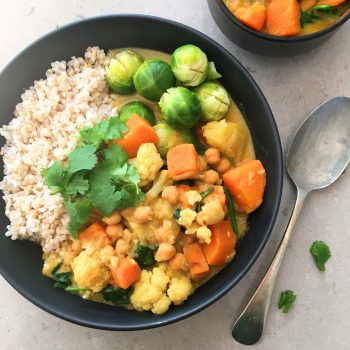 If there were foods that research showed benefitted virtually every aspect of your health, you should know about them. If you could increase certain foods in your diet and by doing so lower your chance of heart disease, cancer and diabetes, you’d want to know about them. Well it is simple: Increase your consumption of veggies and legumes and you are on a winner.
If there were foods that research showed benefitted virtually every aspect of your health, you should know about them. If you could increase certain foods in your diet and by doing so lower your chance of heart disease, cancer and diabetes, you’d want to know about them. Well it is simple: Increase your consumption of veggies and legumes and you are on a winner.
Here at Perth Health and Fertility, we love getting our patients to eat more veggies and more legumes, so they can reap the benefits of these nutrient powerhouses! There are so many reasons to include these foods in your diet; one that is often forgotten is that they provide food for the healthy bacteria in your gut. Remember the more DIFFERENT plant foods you eat, the healthier and more diverse your gut microbiota will be. When we eat the same foods over and over, we only feed a very small amount of the beneficial bacteria and the rest starve! Not a good idea!
Legumes (kidney beans, chickpeas, lentils etc) are also a fantastic vegetarian protein source, rich in fibre and nutrients like iron, folate and magnesium. Like legumes, vegetables are also high in fibre, as well vitamins, antioxidants and plant-based chemicals called polyphenols. Fibre is SO IMPORTANT for your health, helping to regulate digestion, stabilise energy levels and keep you fuller for longer. Fibre also helps soften the stool, to prevent constipation and ensure regular bowel movements.
Research suggests more than 80% of Australian adults are not eating the recommended five serves of vegetables per day, and sadly, the statistics are even worse for children. This is a serious problem, as veggies can help protect against a wide range of conditions, like diabetes, heart disease, various cancers, obesity and constipation.
So what counts as a serve of vegetables? According to the National Health and Medical Research Council, a single serve of vegetables is approximately 75g, or:
- 1/2 a cup of cooked green, orange or yellow veggies (e.g. capsicum, spinach, broccoli, carrots etc)
- 1 cup of raw salad vegetables (e.g. lettuce, spinach, cucumber, raw capsicum etc)
- 1/2 of a medium starchy vegetable (such as potatoes or sweet potatoes)
- 1/2 a cup of legumes (e.g. chickpeas, kidney beans, lentils, peas etc)
While the classic “2 and 5 serves of fruit and veg” is a great starting point, research suggests TEN SERVES is even better for long-term health and disease prevention. In a recent study of over 2 million people, those who ate at least 800g of vegetables a day had significantly reduced risk of heart disease, cancer, stroke and all-cause mortality. While this might sound like a lot, once you start working some fruit or veg into every meal, it quickly adds up. For example:
- Breakfast: Oats, with some Greek yoghurt, 1 grated apple and 150g blueberries (2 serves of fruit)
- Lunch: A salad with 1 cups of leafy greens, 1 cup chopped raw veg (cucumber, snowpeas, capsicum etc), 1/2 an avocado and 1/2 cup brown lentils (4 serves of vegetables)
- Dinner: Chicken stir-fry with brown rice and 1.5 cups cooked vegetables (broccoli, onion, mushrooms, green beans, capsicum etc) (3 serves of vegetables)
- Dessert: 1 piece of fruit (e.g. a nectarine, an orange or some berries) (1 serve of fruit)
As you can see, a day of eating like this would easily provide you with at least 10 serves of fruit and vegetables. Having 2-3 vegetarian days a week can also help, especially if you’re someone who eats meat, chicken or fish for both lunch and dinner. Snacks can also be an easy way to increase your fruit and veggie intake, with some of our favourite options listed below:
- Vegetable sticks with hummus
- Guacamole on Lisa’s Lentil and Almond Crackers
- A piece of fruit with a small handful of almonds
- Stewed fruit like apple and pears topped with some nuts and coconut
- A piece of our favourite Chocolate Slice or 1-2 Bone Booster Balls.
- Plain, natural yoghurt with fresh berries
- Homemade chia pudding with fresh berries
- A simple smoothie as an after-school snack for the kids!
- Banana Nice-Cream (which makes a perfect child-friendly dessert!)
Curries, soups and stews are another fantastic way to get those veggies in. A lot of people aren’t very familiar with cooking with legumes so to make it easy we have a great selection of recipes under the Legumes section on our website. One of my favourite things about curries and soups is they can be prepared in advance, and leftovers can be frozen for an easy lunch or dinner option when you’re pressed for time. The recipe below is one I throw together most weeks, as it’s easy to make, freezes well and can be adapted according to what veggies I have on hand.
We want to inspire you to look at your diet and consider ways in which you can increase your fruit and vegetable consumption. Trust us when we say your body, mind, bowel and waist-line will definitely thank you for it!
Sweet Potato and Chickpea Curry
Ingredients
1 tbsp extra-virgin olive oil
1 large brown onion, diced
1-1.5 tbsp curry powder (I use Clive of India, available at Woolies and Coles)*
1.5 tsp cumin
1/2 tsp paprika (not the smoked variety)
2-3 cloves of garlic
1 large carrot, diced
1 medium sweet potato, peeled and diced (approx 400 g)
2 large potatoes, diced (approx 300-400 g)
400g cooked chickpeas (equivalent to approximately 2 tins)
400ml vegetable stock
270ml can of coconut milk
1/2 small head of cauliflower, chopped into florets
Juice of half a lime
2 big handfuls of spinach
Pepper, to taste
Method
- Heat oil in a large saucepan over a medium heat. Add diced onions and cook until soft (1-2 minutes). Stir through the spices and garlic, and cook for another minute or so, until fragrant (don’t let the spices burn!).
- Add the chopped carrot, sweet potato, potatoes and chickpeas, and stir to combine. Add the stock and coconut milk, cover with the lid and bring to a boil.
- Once boiling, reduce the heat to low-medium, and cook for 20-30 minutes, until the vegetables are cooked through.
- Add the cauliflower florets and lime juice, and cook for another 5-10 minutes, until the cauliflower has softened.
- Stir through the spinach and season to taste*.
I like to serve this curry with brown rice or quinoa, a side salad and/or some steamed greens. It is also delicious sprinkled with some fresh coriander and a squeeze of lime.
Notes
- *This makes a yummy, albeit mild curry, to appeal to the whole family. If you prefer a stronger flavour, feel free to add extra curry powder or some chilli.
- If you need more liquid, you can add more coconut milk, vegetable stock, water or something like Coco Quench. Adding more coconut milk is my preferred option, as it makes the curry extra creamy.
- If your curry is too liquid-y, remove the lid and cook for 10-15 minutes over a medium heat, to evaporate off some of the liquid. This also helps breakdown some of the sweet potato and potato, which will help thicken it up a bit.
Enjoy!

